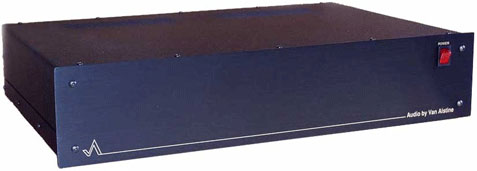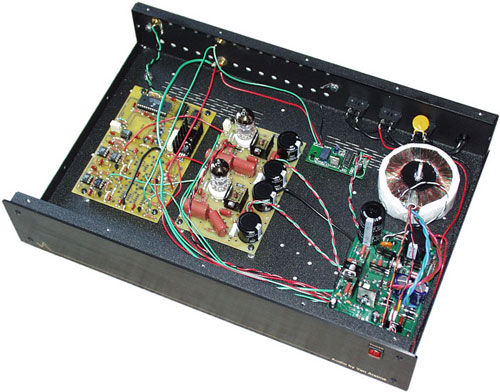Editor’s note: Audio by Van Alstine is well-known for the affordability of its products, and its website (www.avahifi.com) endeavors fully with respectable efforts to raise awareness of the virtues of its products; yet, the equipment are given unremarkable exteriors consistently. As a result, readers looking for high-performance equipment with a visually artistic exterior with which to adorn their listening room will tend to neglect AVA. This month, Dagogoan Doug Schroeder shares his experience and thoughts on using the Audio by Van Alstine Ultra Dac.
I will never forget the Audio by Van Alstine Ultra Dac. It was the first review component nearly to be sent back to the manufacturer with an incorrect diagnosis of damage. It arrived with only three of the four corners of its shipping box squared, yet upon examination looked unscathed. When it was placed into the system, the Pathos Classic One MkIII amp started clicking and the speaker cut out in sync. A tedious process of elimination eventually led to a faulty speaker cable, and the Ultra Dac was exonerated. The speaker cable became faulty at the precise time the Ultra Dac was inserted into the rig – no wonder I initially misjudged the situation. Had I been more familiar with Audio by Van Alstine products, I would have known that was unlikely as they are built to endure.
The creator of the Ultra Dac, Frank Van Alstine, is an iconoclast, a man who loves to wreak havoc on cherished audiophile beliefs. He makes the equipment he sells the old fashioned way – simply and cleanly. His components are about straightforward design, quality for the dollar, and reliability. Getting to know Frank, I get the distinct feeling that if you are not interested in these goals he will be happy to wave goodbye to you and move on to the next potential customer. He knows there are two kinds of consumers in the audiophile world – the ones who want the latest technology and tweaks, and those who want simple, reliable performance eschewing “hot” gear. Frank is focused on serving the latter group.
“With the Ultra Dac, you will get what it takes to get good sound, but you will not get an “overkill” design.”
Aesthetically, and in many ways mechanically, the Ultra Dac hearkens to earlier times. Simplicity is the key word; even in the revved up world of digital signal treatment, simplicity rules the Ultra Dac. The case is uncluttered, showing a stolid black faceplate save for an orange illuminated power switch. A well ventilated cover gives way to a back with precisely three jacks – coaxial digital input and L/R single-ended output. Unlike many components which are built and specified to the hilt, the Audio by Van Alstine is built to the standards of quality, similar in the way that generic food is just as good as premium-branded ones to pass all government requirements. With the Ultra Dac, you will get what it takes to get good sound, but you will not get an “overkill” design.
Though not overbuilt, the internal construction looks clean and efficient. The transformer looks smaller to my eye, but when I mentioned it to Frank he fairly bristled at the suggestion, insisting that it is built to more than adequate specifications for its purpose. By his response, I can see that Frank takes pride in his designs and he doesn’t like anyone suggesting that he’s cutting corners. Nowadays one cannot definitively conclude that a transformer is undersized by appearance, it seems. Even the McIntosh MA-6300 integrated I recently reviewed had a puny-looking transformer. As transformers also undergo development, it seems the old eyeball test of the massiveness of a transformer no longer suffices as a consistent criterion to assess build quality.
Frank is no newcomer to manufacturing components. He began dabbling in DIY audio in 7th grade when he built a 7-watt Heathkit integrated as part of his first system. In college, he sold for a local HiFi dealer, and then began working for the Minnesota Highway Department where he met Paul Jensen, known for his speaker building. Together they chipped in $600 apiece for Dyna, Dual and ADC franchises to begin their business. After Paul passed away, Frank bought out his share of the business and developed Audio by Van Alstine (hereafter referred to as AVA). He has been full-time in the industry since the early 1980’s.
“Frank has very strong opinions of what does and does not influence good design, and in this review a few of those opinions will run contrary to what I’ve learned in this hobby.”
Frank has very strong opinions of what does and does not influence good design, and in this review a few of those opinions will run contrary to what I’ve learned in this hobby. I find Frank’s perspective refreshing, and the Ultra Dac a solid work of craftsmanship. Yet, on a few details I believe influence the bottom line performance of the Ultra Dac, I shall be respectfully questioning its intentionally devised limitations.
The Ultra Dac is a component which will force the audiophile to make a decision either for or against generally accepted audiophile manufacturing practices, such as the almost universal use of the IEC connector along with aftermarket power cords, or the widely accepted use of upsampling in digital players and DACs.
While many designers hide behind a corporate bulwark, Frank darts out into “no man’s land” and takes shots at the principles of subjectivists. He “pulls no punches” in his literature, which targets both those who endorse pricey cables as well as, it seems, those who make and use high-end transports. He seems to hold firmly to an objectivist perspective, which tends to discount improvements which are not measurable.
I was disenchanted initially during a phone call placed to Frank in the early stages of this review as we discussed the absence of an IEC on the Ultra Dac. I have come to expect them as a standard feature on equipment, and when I saw the traditional AC power cord similar to one on a toaster, I shared my surprise with him. He dismissed it completely, likening an aftermarket power cord to, “… what polish to use on the rails of the Titanic,” in other words, of no importance to the outcome. I have to admit, I laughed – what an illustration! I may completely disagree, but I have to at least admit that Frank is funny!
Comments in the AVA literature accompanying the Ultra Dac leave little room for pursuit of anything but measurable results in design. It states regarding the selection of interconnects to be used from CD player to the Ultra Dac, “The cable set that came with your CD player will work fine for this use.” I have heard such important improvements in sound from specialized, properly placed interconnects that I don’t use stock interconnects anymore. The literature also states, “…we have found that the brand, cost, and design of the associated CD player is not important.” Say What? As I kept reading the Ultra Dac Operating Instructions, my jaw kept dropping closer to the floor. Frank Van Alstine is not merely out to make gear, he’s out to crusade for the objectivist audiophile worldview.
Frank’s view can also be illustrated at the vivid analogy he used in response to my interview question reprinted below:
13. What do you say to someone who suggests the Ultra Dac is
hindered by the absence of an IEC, allowing an aftermarket power
cord?
(Frank’s response) They are believing the witch doctors, dancing
around the fire waving gourds.
This is wonderful rhetoric, but it is unsatisfactory to me as an audiophile and reviewer. To completely dismiss the efficacy of cables in high-end audio systems, to me, seems unthinkable. Often, objectivists proclaim that cables cannot influence sound, and they point to measurements. I will say that the measurements are unsatisfactory to reveal the nuances which the ear can perceive. As for blind testing, I assert the mind is incapable of highly consistent, hyper-critical, auditory recall and fails to identify accurately these same nuances in double bind tests.
Until someone can demonstrate the sound of an electron, the subject remains unsettled and my explanation in principle is plausible.
“… it matters not one whit whether a designer/manufacturer is an objectivist or a subjectivist. The audiophile cares most in the end about one thing – the sound of the product relative to its cost.”
In an important sense, it matters not one whit whether a designer/manufacturer is an objectivist or a subjectivist. The audiophile cares most in the end about one thing – the sound of the product relative to its cost. What is pertinent to the outcome, however, is that the philosophy which guides development of a component vastly influences the outcome. If measurements are critical, then any number of reliable means to obtain them can be used, i.e. standard power cord or IEC; low cost or audiophile quality transport. If, on the other hand, the subjective assessment of sound following measurement is the goal, then a large number of perfectly good objective means are ruled out in search of the few or one which will satisfy. A manufacturer has to decide which will take precedence, and with AVA the decision is clear. Frank has left little width to the line in the sand he has drawn here, and his components reflect it.
For this reason, the potential owner of the AVA Ultra Dac also has to be clear about whether things like aftermarket power cords and the perceived quality of transport is important. If not, then the AVA components represent a great opportunity to own electronics built truly to last as nearly a lifetime as any available today. However, if the elements considered by many, including myself, to be indispensable to ultimate sound (such as the IEC or upsampling) are critical, then the reader needs to realize that options are intentionally limited with AVA gear.
I will continue now to some listening impressions and an evaluation of the sound of the Ultra Dac, followed by the technological reasons for my conclusions. The overall impression I received from the Ultra Dac is that it is a very competent, clean 16-bit DAC – precisely what it was intended to be. The sound is as lovely as any quality 16-bit player I have used. One of the most comely aspects of the Ultra Dac sound is a wonderfully warm tonality, the strongest attribute of its performance. Some tube players and DACs border on SS edginess, so much so that when paired with revealing speakers the combination is neigh unto unlistenable, especially at higher levels. The Ultra Dac stays solidly in the “comfort listening” zone as it has a glow and laid back tonality classically associated with tube gear. It strikes me as the DAC equivalent to a warm, rich and comfy-cozy sounding loudspeaker.
Frank has done an excellent job in this respect, and his experience with tube gear shines through. There are so many technical and harsh sounding players that it’s refreshing to hear a DAC that relaxes the ears. One way to achieve this “warm” sound is by rolling off the highest frequencies, and it sounds like this is what the Ultra Dac does. The DAC may or may not measure out to the human hearing limit, but that is a separate matter from the actual sonic experience in a system. I mentioned this warm and forgiving sound to Frank as I thought the unit may have been designed for tonal richness as the highest priority. He clarified, “The design goal is simply not to screw up the source material.” That seemed rather self-evident to me, but I took it to mean that precision, likely measured precision of the signal, was the goal.
- (Page 1 of 2)
- Next page →

